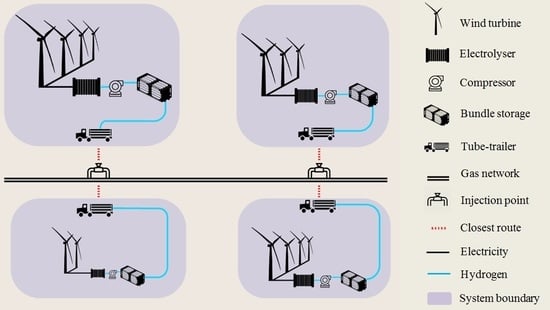At What Cost Can Renewable Hydrogen Offset Fossil Fuel Use in Ireland’s Gas Network?
Abstract
1. Introduction
1.1. Hydrogen Production System Optimisation
1.2. Wind-Based Hydrogen and Grid Injection
1.3. Objectives and Outline
2. Method
2.1. System and Scenario Description
2.1.1. First Scenario: Curtailed Wind Operation
2.1.2. Second Scenario: Available Wind Operation
2.1.3. Third Scenario: Full Capacity Operation
2.2. Techno-Economic Submodel
2.3. System Sizing Submodel
2.4. Wind Curtailment Submodel
2.4.1. Wind Farms Larger than 10 MWe
2.4.2. Wind Farms Smaller than 10 MWe
2.5. Transportation Submodel
2.6. Solution Algorithm Overview
3. Results and Discussions
3.1. System Sizing for a Sample Wind Farm
3.2. Optimal System Sizing for all Irish Wind Farms
3.3. Energy Analyis for all Scenarios
3.4. LCOH Analysis for All Scenarios
3.5. Overall Share of Hydrogen in Natural Gas Network
3.6. Sensitivity Analysis of Techno-Economic Parameters
3.7. Technical Challenges for Injection into the Natural Gas Network
4. Conclusions
Author Contributions
Funding
Acknowledgments
Conflicts of Interest
Abbreviations
| AGI | Above ground installation |
| Electricity price, €/kWh | |
| Cost, € | |
| Kilometric cost, €/km | |
| Energy, MWh | |
| GIS | Geographic Information System |
| GNI | Gas Networks Ireland |
| Distance between wind farm and AGI, km | |
| Levelised cost of energy, €/MWh | |
| Levelised cost of hydrogen, €/kg | |
| Annual mass, kg/year | |
| Average mass, kg/hour | |
| Number of trips per year, trips/y | |
| Electrolyser specific size, MWe | |
| Pressure, barg | |
| Power, MWe | |
| Discount rate, % | |
| Time, hour | |
| Time, year | |
| SEMO | Single Electricity Market Operator |
| Greek symbols | |
| Capacity factor, % | |
| Economic lifetime, year | |
| Specific energy consumption, kWh/kg | |
| Specific energy consumption, kWh/km | |
| Subscripts and superscripts | |
| AW | Available wind |
| EC | Electric compressor |
| CW | Curtailed wind |
| DQ | Dispatch quantity |
| EL | Electricity |
| EM | Energy management unit |
| Eng | Engineering |
| EW | Exportable wind |
| FOM | Fixed operation & maintenance |
| EG | Electricity grid |
| H2 | Hydrogen gas |
| H2O | Water |
| ICS | Interconnection, commissioning, and start-up |
| in | Inlet condition |
| inv | Investment capital |
| MG | Metered generation |
| O2 | Oxygen gas |
| OM | Operation and maintenance |
| opt | Optimum size |
| Other | Other expenditure |
| out | Outlet condition |
| prod | Production |
| R | Retest of tube trailer |
| SR | Electrolyser stack replacement |
| SV | Storage vessel |
| total | Summary of production and transportation |
| trans | Transportation |
| trip | Occurrence of hydrogen delivery |
| TT | Tube trailer |
| VOM | Variable operation & maintenance |
| WE | Water electrolyser |
| WF | Wind farm |
| WHS | Wind-hydrogen system |
References
- IRENA. Renewable Capacity Statistics 2019, International Renewable Energy Agency (IRENA); IRENA: Abu Dhabi, UAE, 2019.
- EirGrid; SONI. Annual Renewable Energy Constraint and Curtailment Report 2018; EirGrid: Dublin, Ireland, 2019. [Google Scholar]
- Turner, M.; Zhang, Y.; Rix, O. 70 By 30: A 70% Renewable Electricity Vision for Ireland in 2030; Baringa Partners LLP: London, UK, 2018. [Google Scholar]
- Department of Communications Climate Action & Environment of Government of Ireland. Renewable Electricity Support Scheme (RESS); Department of Communications Climate Action & Environment of Government of Ireland: Dublin, Ireland, 2020.
- WindEurope. WindEurope Views on Curtailment of Wind Power and its Links to Priority Dispatch; WindEurope: Brussels, Belgium, 2016. [Google Scholar]
- Garrigle, E.V.M.; Deane, J.P.; Leahy, P.G. How much wind energy will be curtailed on the 2020 Irish power system? Renew. Energy 2013, 55, 544–553. [Google Scholar] [CrossRef]
- Zhang, G.; Wan, X. A wind-hydrogen energy storage system model for massive wind energy curtailment. Int. J. Hydrogen Energy 2014, 39, 1243–1252. [Google Scholar] [CrossRef]
- Reddi, K.; Elgowainy, A.; Rustagi, N.; Gupta, E. Techno-economic analysis of conventional and advanced high-pressure tube trailer configurations for compressed hydrogen gas transportation and refueling. Int. J. Hydrogen Energy 2018, 43, 4428–4438. [Google Scholar] [CrossRef]
- Melaina, M.; Antonia, O.; Penev, M. Blending Hydrogen into Natural Gas Pipeline Networks: A Review of Key Issues; National Renewable Energy Laboratory: Golden, CO, USA, 2013.
- SEAI. Energy in Ireland; SEAI: Dublin, Ireland, 2019. [Google Scholar]
- Beccali, M.; Brunone, S.; Finocchiaro, P.; Galletto, J.M. Method for size optimisation of large wind-hydrogen systems with high penetration on power grids. Appl. Energy 2013, 102, 534–544. [Google Scholar] [CrossRef]
- Ashrafi, Z.N.; Ghasemian, M.; Shahrestani, M.I.; Khodabandeh, E.; Sedaghat, A. Evaluation of hydrogen production from harvesting wind energy at high altitudes in Iran by three extrapolating Weibull methods. Int. J. Hydrogen Energy 2018, 43, 3110–3132. [Google Scholar] [CrossRef]
- Quarton, C.J.; Samsatli, S. Power-to-gas for injection into the gas grid: What can we learn from real-life projects, economic assessments and systems modelling? Renew. Sustain. Energy Rev. 2018, 98, 302–316. [Google Scholar] [CrossRef]
- Vo Truc, T.Q.; Xia, A.; Wall, D.M.; Murphy, J.D. Use of surplus wind electricity in Ireland to produce compressed renewable gaseous transport fuel through biological power to gas systems. Renew. Energy 2017, 105, 495–504. [Google Scholar]
- McDonagh, S.; Deane, P.; Rajendran, K.; Murphy, J.D. Are electrofuels a sustainable transport fuel? Analysis of the effect of controls on carbon, curtailment, and cost of hydrogen. Appl. Energy 2019, 247, 716–730. [Google Scholar] [CrossRef]
- Singlitico, A.; Goggins, J.; Monaghan, R.F.D. Evaluation of the potential and geospatial distribution of waste and residues for bio-SNG production: A case study for the Republic of Ireland. Renew. Sustain. Energy Rev. 2018, 98, 288–301. [Google Scholar] [CrossRef]
- Singlitico, A.; Goggins, J.; Monaghan, R.F.D. Life Cycle Assessment-Based Multiobjective Optimisation of Synthetic Natural Gas Supply Chain: A Case Study for the Republic of Ireland. J. Clean. Prod. 2020, in press. [Google Scholar] [CrossRef]
- Gas Networks Ireland. Vision 2050: A Net Zero Carbon Gas Network for Ireland; Gas Networks Ireland: Cork, Ireland, 2019. [Google Scholar]
- Chardonnet, C.; Giordano, V.; de Vos, L.; Bart, F. Study on Early Business Cases for H2 in Energy Storage and More Broadly Power to H2 Applications; FCH-JU: Brussels, Belgium, 2017. [Google Scholar]
- Götz, M.; Lefebvre, J.; Mörs, F.; Koch, A.M.; Graf, F.; Bajohr, S.; Reimert, R.; Kolb, T. Renewable Power-to-Gas: A technological and economic review. Renew. Energy 2016, 85, 1371–1390. [Google Scholar] [CrossRef]
- Kuckshinrichs, W.; Ketelaer, T.; Koj, J.C. Economic analysis of improved alkaline water electrolysis. Front. Energy Res. 2017, 5, 1. [Google Scholar] [CrossRef]
- Siyal, S.H.; Mentis, D.; Howells, M. Economic analysis of standalone wind-powered hydrogen refueling stations for road transport at selected sites in Sweden. Int. J. Hydrogen Energy 2015, 40, 9855–9865. [Google Scholar] [CrossRef]
- Viktorsson, L.; Heinonen, J.T.; Skulason, J.B.; Unnthorsson, R. A step towards the hydrogen economy - A life cycle cost analysis of a hydrogen refueling station. Energies 2017, 10, 763. [Google Scholar] [CrossRef]
- Scottish Entreprise. Constrained Renewables and Green Hydrogen Production Study Final Report; Scottish Entreprise: Glasgow, UK, 2018. [Google Scholar]
- Glenk, G.; Reichelstein, S. Economics of converting renewable power to hydrogen. Nat. Energy 2019, 4, 216–222. [Google Scholar] [CrossRef]
- Schmidt, O.; Gambhir, A.; Staffell, I.; Hawkes, A.; Nelson, J.; Few, S. Future cost and performance of water electrolysis: An expert elicitation study. Int. J. Hydrogen Energy 2017, 42, 30470–30492. [Google Scholar] [CrossRef]
- Proost, J. State-of-the art CAPEX data for water electrolysers, and their impact on renewable hydrogen price settings. Int. J. Hydrogen Energy 2019, 44, 4406–4413. [Google Scholar] [CrossRef]
- Linnemann, J.; Steinberger-Wilckens, R. Realistic costs of wind-hydrogen vehicle fuel production. Int. J. Hydrogen Energy 2007, 32, 1492–1499. [Google Scholar] [CrossRef]
- Greiner, C.J.; KorpÅs, M.; Holen, A.T. A Norwegian case study on the production of hydrogen from wind power. Int. J. Hydrogen Energy 2007, 32, 1500–1507. [Google Scholar] [CrossRef]
- SEM Committee. SEM Monitoring Report: Q3 2018 November 2018; SEM Committee: Dublin, Ireland, 2018. [Google Scholar]
- Parra, D.; Valverde, L.; Pino, F.J.; Patel, M.K. A review on the role, cost and value of hydrogen energy systems for deep decarbonisation. Renew. Sustain. Energy Rev. 2019, 101, 279–294. [Google Scholar] [CrossRef]
- SEAI. Electricity & Gas Prices in Ireland; Sustainable Energy Authority of Ireland: Dublin, Ireland, 2018. [Google Scholar]
- SEM Committee. Single Electricity Market Performance; SEM Committee: Dublin, Ireland, 2019. [Google Scholar]
- Louw, A.; Boyle, R.; Strahan, D.; Collins, B.; Kimmel, M.; Giannakopoulou, E.; Becker, L. Global Trends in Renewable Energy Investment 2018; Frankfurt School of Finance & Management gGmbH.: Frankfurt, Germany, 2018. [Google Scholar]
- National Competitiveness Council. Costs of Doing Business in Ireland 2018; National Competitiveness Council: Makati, Philippines, 2018. [Google Scholar]
- Léon, A. Hydrogen Storage. In Hydrogen Technology: Mobile and Portable Applications; Springer: Berlin, Germany, 2008; p. 86. [Google Scholar]
- Hall, S. Fans, Blowers, and Compressors. In Rules of Thumb for Chemical Engineers; Gulf Professional Publishing: Houston, TX, USA, 2012; p. 123. [Google Scholar]
- Saur, G. Wind-To-Hydrogen Project: Electrolyzer Capital Cost Study; Technical Report NREL/TP-550-44103; National Renewable Energy Laboratory: Golden, CO, USA, 2008.
- Papadopoulos, V.; Desmet, J.; Knockaert, J.; Develder, C. Improving the utilization factor of a PEM electrolyzer powered by a 15 MW PV park by combining wind power and battery storage—Feasibility study. Int. J. Hydrogen Energy 2018, 43, 16468–16478. [Google Scholar] [CrossRef]
- Bertuccioli, L.; Chan, A.; Hart, D.; Lehner, F.; Madden, B.; Standen, E. Study on Development of Water Electrolysis in the EU—Final Report; FCH JU: Bruxelles, Belgium, 2014. [Google Scholar]
- Buttler, A.; Spliethoff, H. Current status of water electrolysis for energy storage, grid balancing and sector coupling via power-to-gas and power-to-liquids: A review. Renew. Sustain. Energy Rev. 2018, 82, 2440–2454. [Google Scholar] [CrossRef]
- Jiang, Y.; Deng, Z.; You, S. Size optimization and economic analysis of a coupled wind-hydrogen system with curtailment decisions. Int. J. Hydrogen Energy 2019, 44, 19658–19666. [Google Scholar] [CrossRef]
- TSC-Part-B-Glossary. Single Electricity Market Operator. 2018. Available online: www.sem-o.com/MarketDevelopment/MarketRules/Glossary.docx (accessed on 10 August 2018).
- EirGrid; SONI. Annual Renewable Energy Constraint and Curtailment Report 2014; EirGrid: Dublin, Ireland, 2015; pp. 1–28. [Google Scholar]
- O’Shea, R.; Wall, D.; Kilgallon, I.; Murphy, J.D. Assessment of the impact of incentives and of scale on the build order and location of biomethane facilities and the feedstock they utilise. Appl. Energy 2016, 182, 394–408. [Google Scholar] [CrossRef]
- Singlitico, A.; Kilgallon, I.; Goggins, J.; Monaghan, R.F.D. GIS-based techno-economic optimisation of a regional supply chain for large-scale deployment of bio-SNG in a natural gas network. Appl. Energy 2019, 250, 1036–1052. [Google Scholar] [CrossRef]
- GNI (UK) Limited. Northern Ireland Gas Capacity Statement 2018/19; GNI (UK) Limited: London, UK, 2018. [Google Scholar]
- Barbier, F. Hydrogen Distribution Infrastructure for an Energy System: Present Status and Perspectives of Technologies; John Wiley & Sons, Inc.: Hoboken, NJ, USA, 2013; pp. 1–33. [Google Scholar]
- SEAI Wind Mapping System. 2016. Available online: http://maps.seai.ie/wind/ (accessed on 10 October 2019).
- RenewableUK. Onshore Wind Farms in the UK. 2016. Available online: https://www.arcgis.com/home/item.html?id=8bad1da3b2d14a90bf22a7d0b52dc9b3 (accessed on 10 October 2019).
- Geofabrik GmbH. OpenStreetMap Data Extracts. 2019. Available online: http://download.geofabrik.de/ (accessed on 10 January 2019).
- Gas Networks Ireland. The Future of Transport—Case Study: Comparison of a Natural Gas Truck Versus a Diesel Truck; Gas Networks Ireland: Cork, Ireland, 2014. [Google Scholar]
- Roberts, S.; Williams, T. Common Arrangements for Gas: Final Report on the Requirements for a Single Natural Gas Quality Standard for Northern Ireland and the Republic of Ireland; CRU Ireland: Tallaght, Ireland, 2008. [Google Scholar]
- Leicher, J.; Nowakowski, T.; Giese, A.; Görner, K. Power-to-gas and the consequences: Impact of higher hydrogen concentrations in natural gas on industrial combustion processes. Energy Procedia 2017, 120, 96–103. [Google Scholar] [CrossRef]
- De Vries, H.; Mokhov, A.V.; Levinsky, H.B. The impact of natural gas/hydrogen mixtures on the performance of end-use equipment: Interchangeability analysis for domestic appliances. Appl. Energy 2017, 208, 1007–1019. [Google Scholar] [CrossRef]
- Andersson, M.; Larfeldt, J.; Larsson, A.; Finansierats, D.S.H. Co-Firing with Hydrogen in Industrial Gas Turbines (Sameldning Med Vätgas i Industriella Gasturbiner); Svenskt gastekniskt center: Malmö, Sweden, 2013. [Google Scholar]
- Commission for Regulation of Utilities. Gas Networks Ireland Transmission Tariffs and Allowed Revenue 2019/20; Commission for Regulation of Utilities: Tallaght, Ireland, 2019; p. 13. [Google Scholar]
- Commission for Regulation of Utilities. Biogas injection into the Natural Gas Grid; Commission for Regulation of Utilities: Tallaght, Ireland, 2013. [Google Scholar]



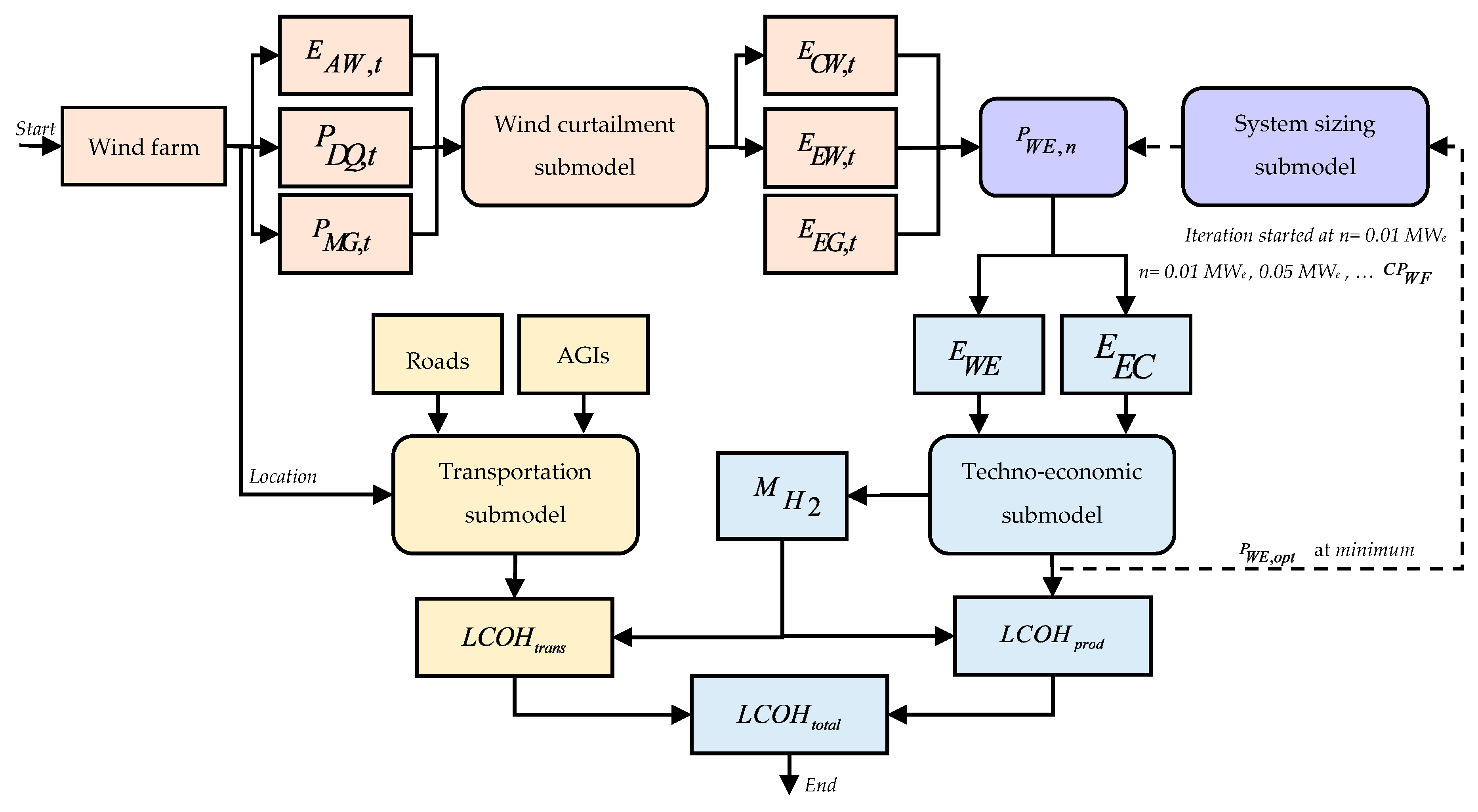
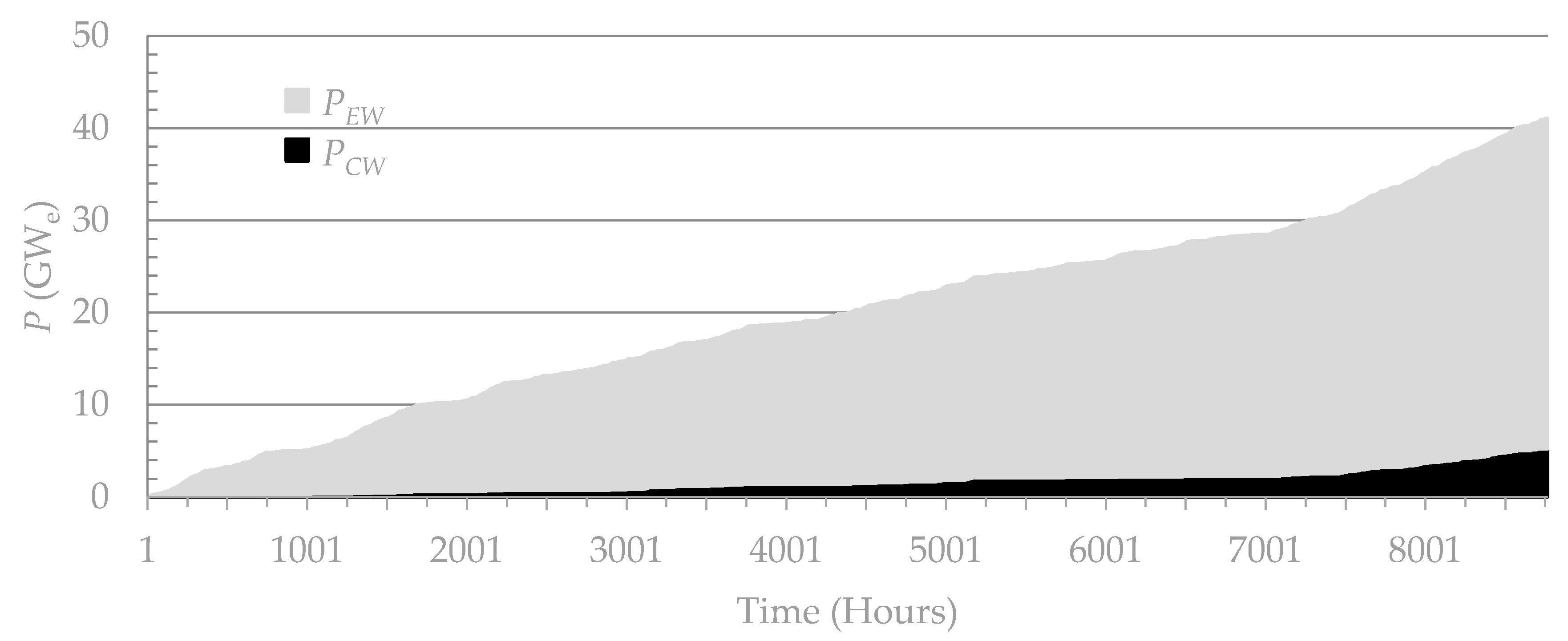
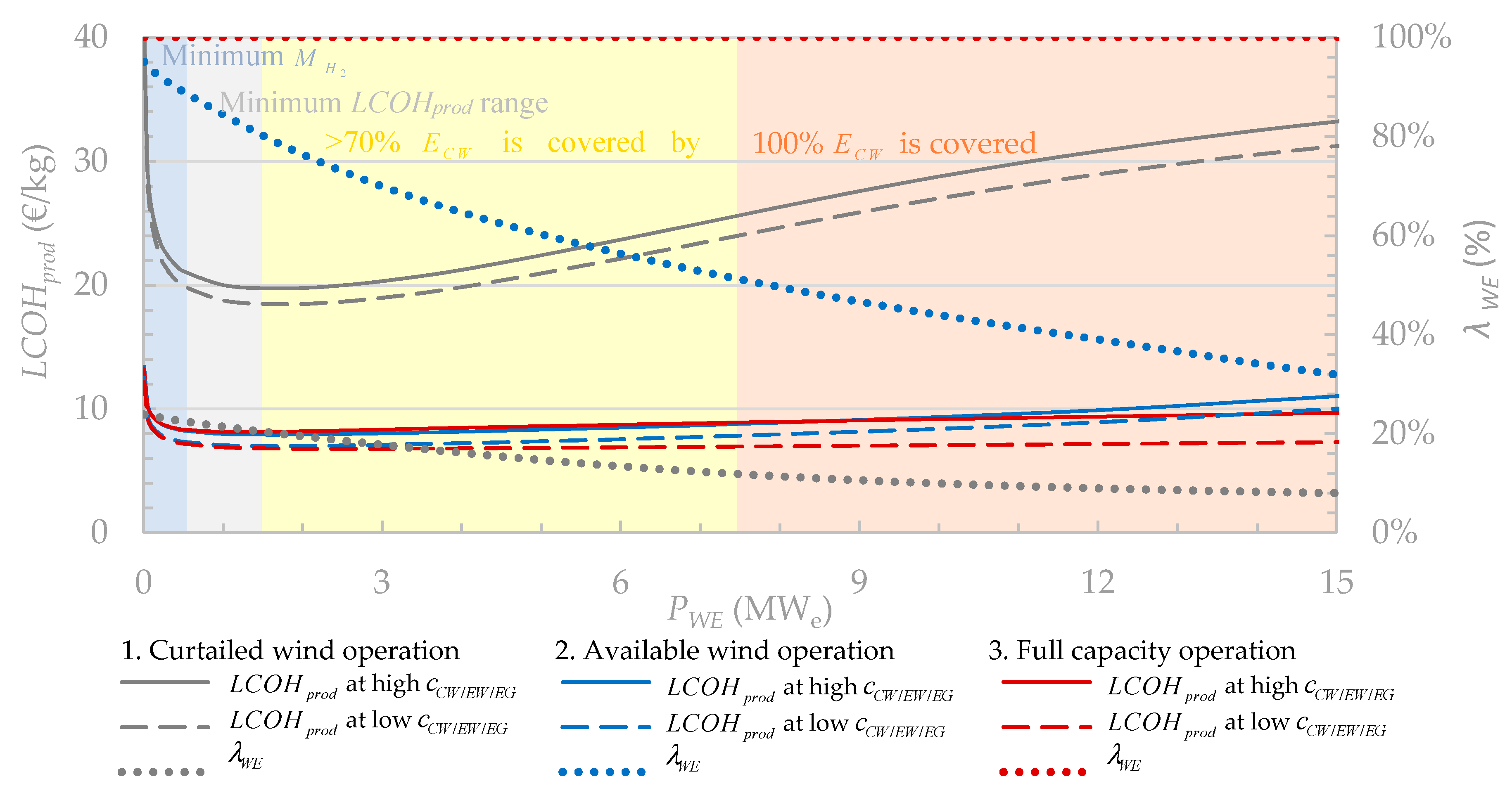
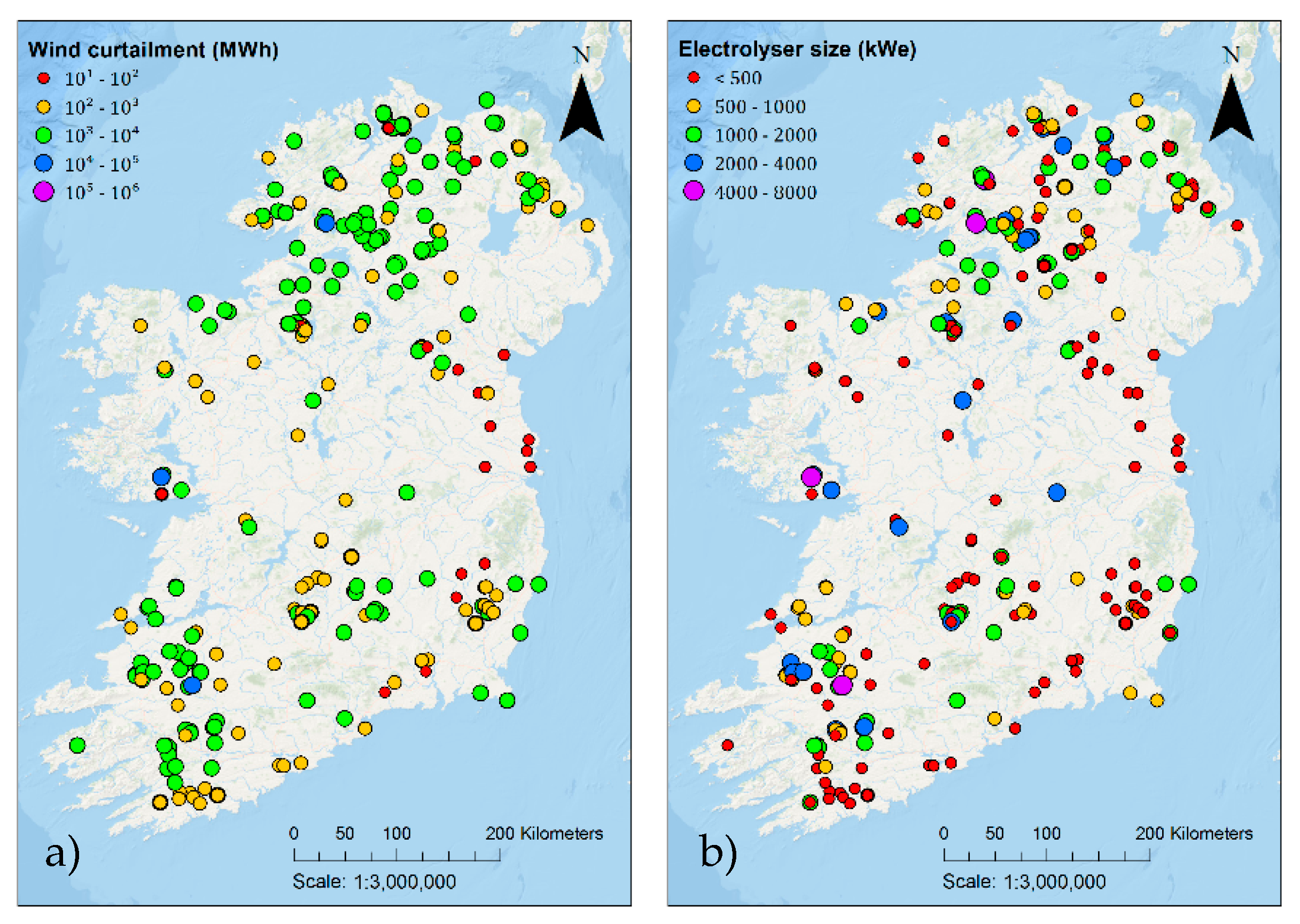
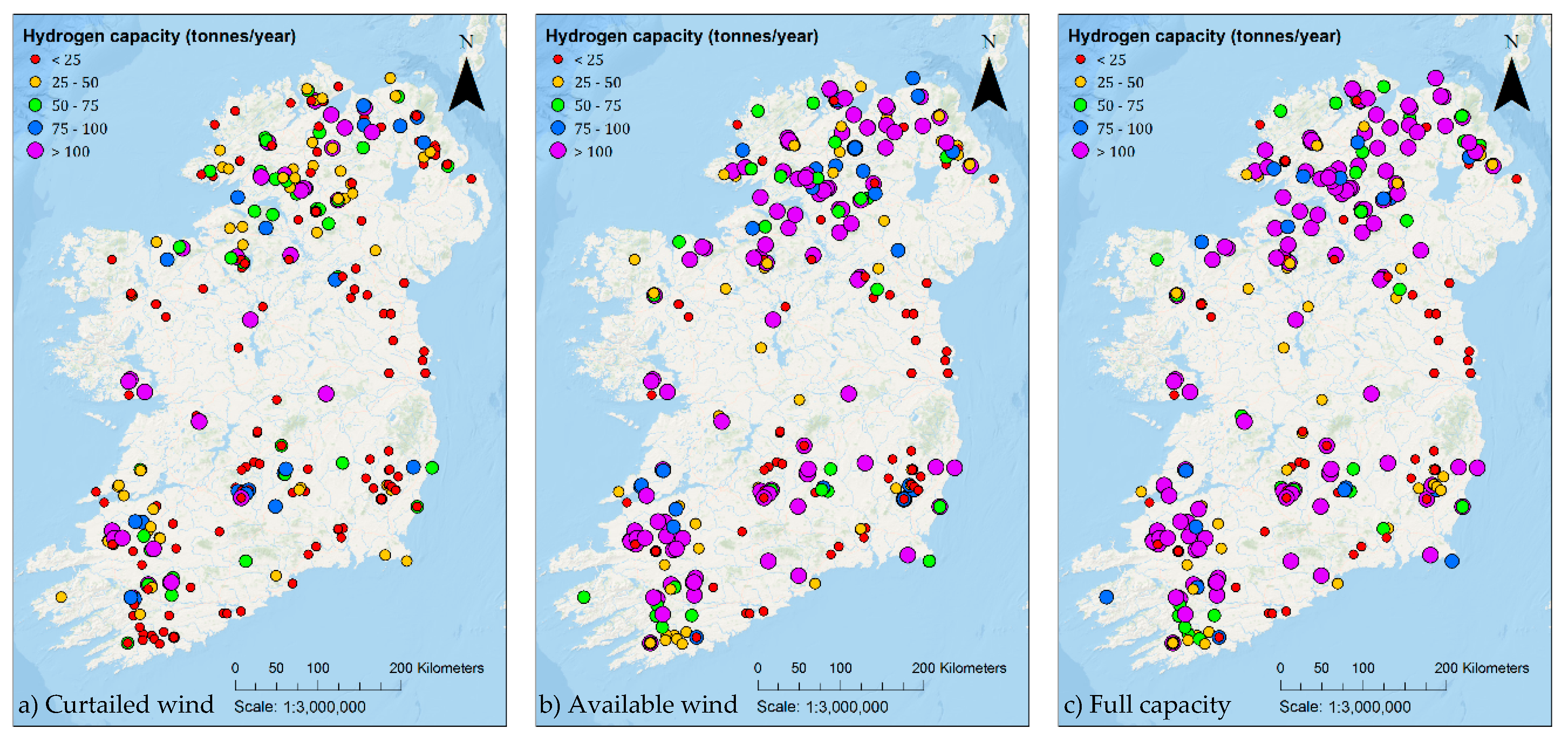
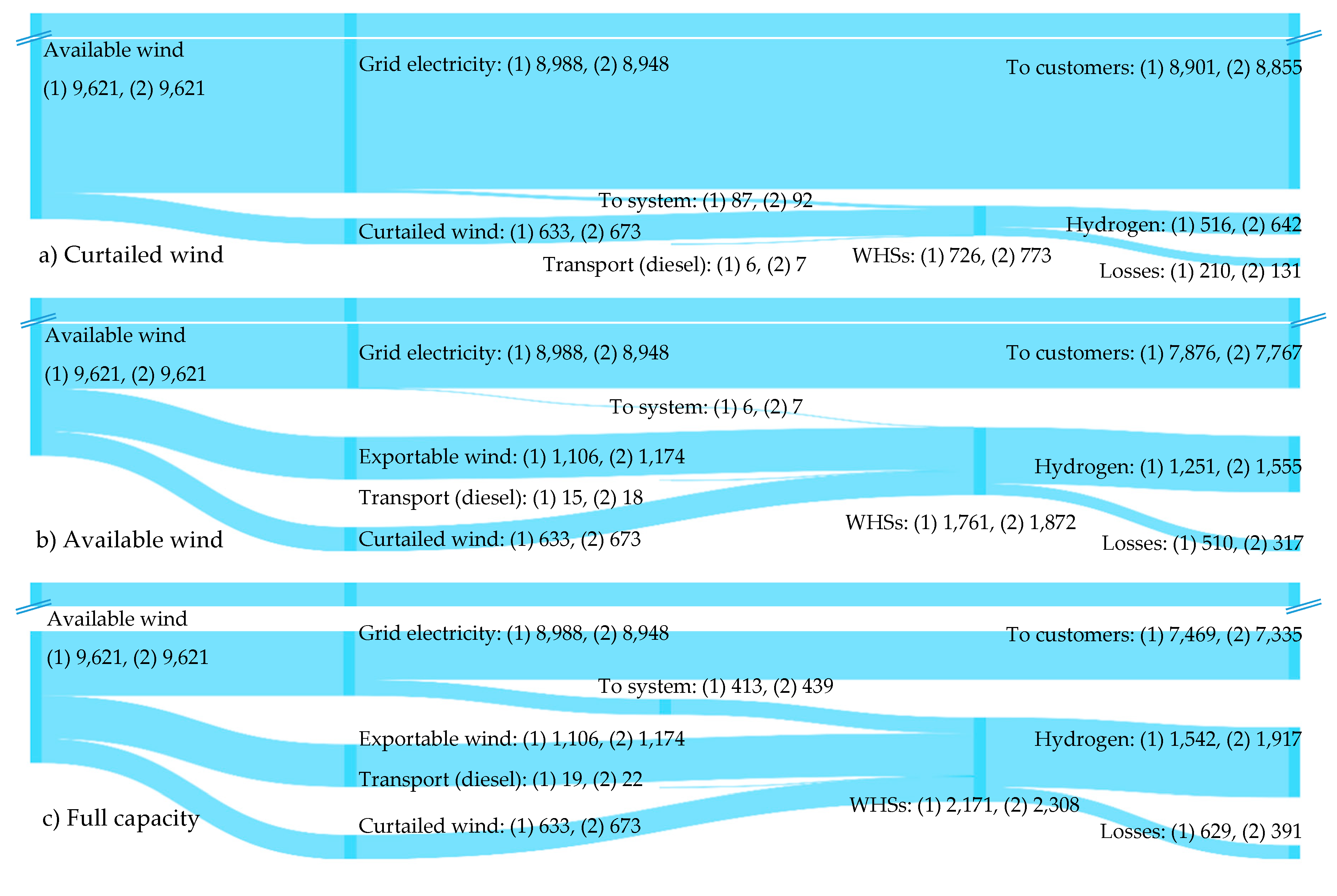
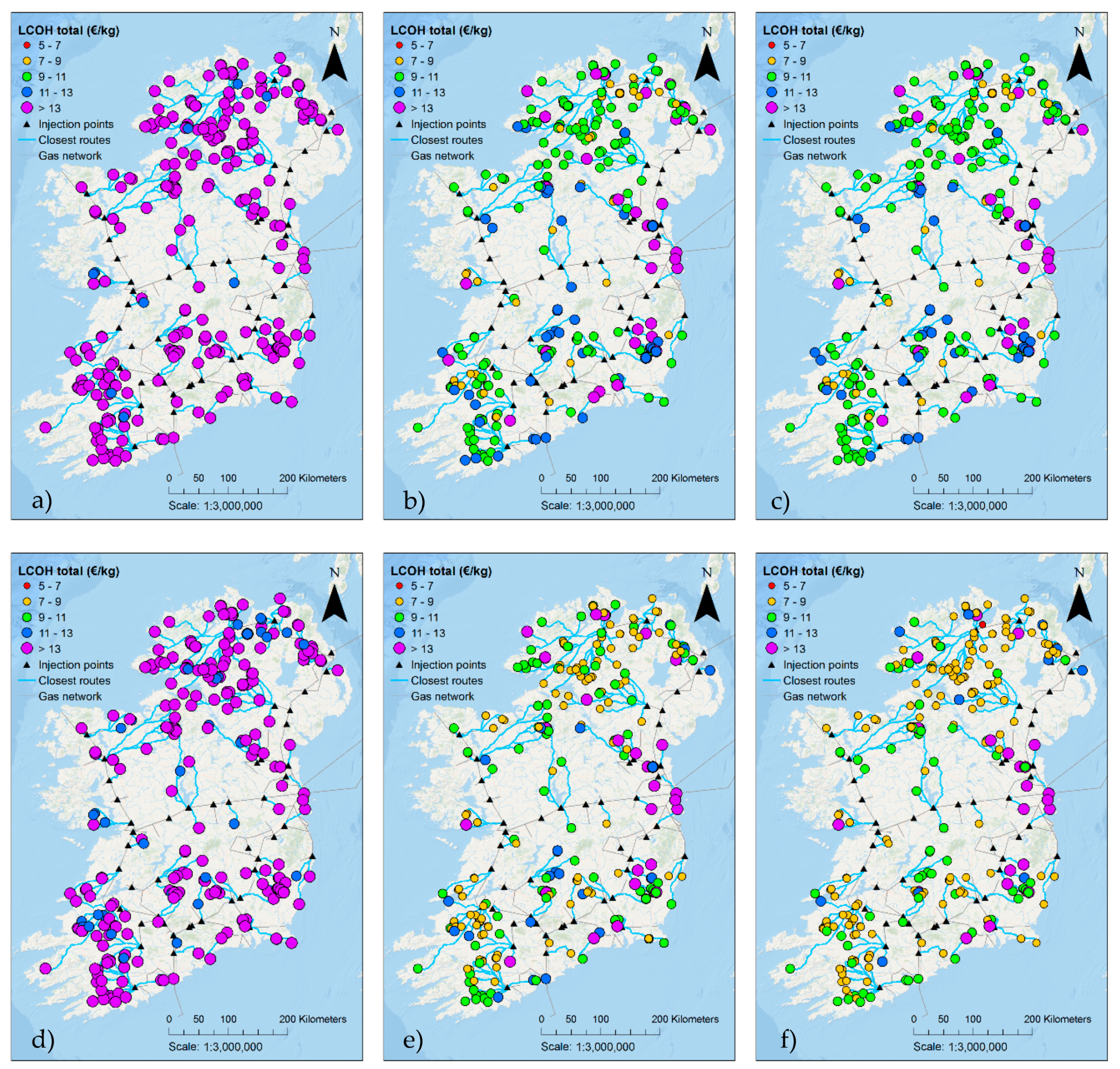
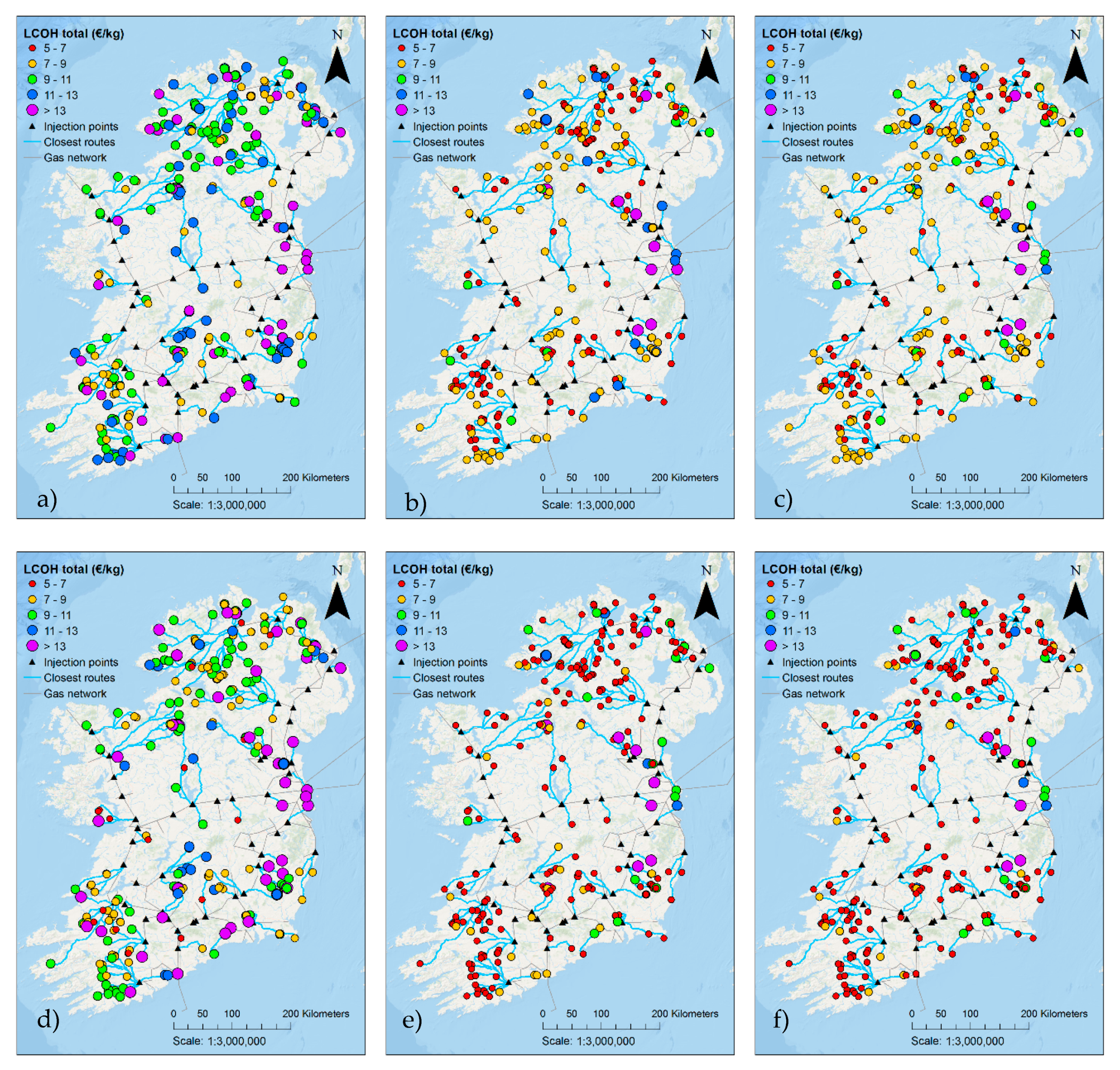

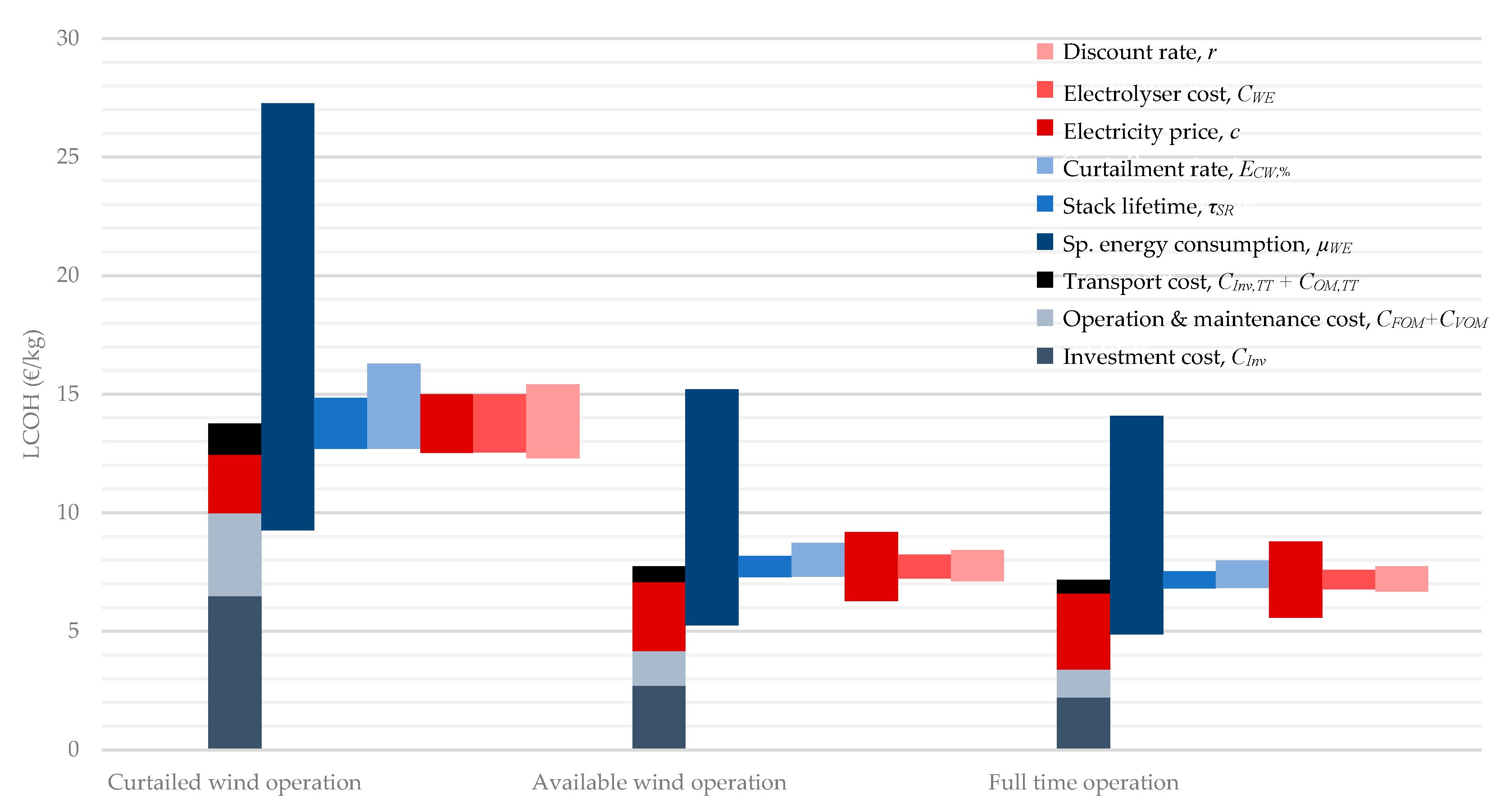
| Cost Component | Symbol | Unit | Values | Ref | |
|---|---|---|---|---|---|
| Investment cost | Current | Future | |||
| Electrolyser | € | [25,26,27] | |||
| Compressor | € | [19,31] | |||
| Storage vessel | € | [19,31] | |||
| Main equipment | € | [19] | |||
| Energy mgt. unit | € | [19] | |||
| Interconnection | € | [19] | |||
| Engineering | € | [19] | |||
| Other cost | € | [19] | |||
| Operation & maintenance cost | Current | Future | |||
| Electrolyser | € | [19] | |||
| Compressor | € | [19] | |||
| Storage vessel | € | [19] | |||
| Stack replacement | € | [25,27] | |||
| Electricity & water prices | Low | High | |||
| Grid electricity | €/kWh | 0.104 | 0.157 | [32] | |
| Exportable wind | €/kWh | 0.072 | 0.093 | [33] | |
| Curtailed wind | €/kWh | 0.050 | 0.065 | [34] | |
| Water | €/m3 | 2.38 | 2.38 | [35] | |
| Parameters | Symbol | Units | Values | Ref. | |
|---|---|---|---|---|---|
| Electrolyser subsystem | Current | Future | |||
| Electrolyser rated power | PWE,n | MWe | 0.01 to PWF | 0.01 to PWF | [19] |
| Operating pressure | pWE | barg | 30 | 30 | [39] |
| Specific energy consumption | µWE | kWhe/kg | 55 | 47 | [26,40,41] |
| Water consumption | ρWE | L/kg | 15 | 15 | [19] |
| Stack lifetime | τSR | years | 5 | 8 | [26] |
| Compressor subsystem | Current | Future | |||
| Pressure input | pEC,in | barg | 30 | 30 | [19] |
| Pressure output | pEC,out | barg | 300 | 300 | [19] |
| Specific energy consumption | µEC | kWhe/kg | 1.7 | 1.7 | [19,37] |
| Storage subsystem | Current | Future | |||
| Operating pressure | pSV | barg | 300 | 300 | [22] |
| Parameters | Symbol | Unit | Values | Ref | |
|---|---|---|---|---|---|
| Economic parameters | Current | Future | |||
| Tube trailer cost | € | 232,000 | 232,000 | [24] | |
| Operational cost | €/km | 1.9 | 1.9 | [24] | |
| Maintenance cost | €/km | 0.13 | 0.13 | [24] | |
| Retest cost | € | [19] | |||
| Technical parameters | Current | Future | |||
| Tube trailer capacity | kg | 500 | 500 | [48] | |
| Operating pressure | barg | 300 | 300 | [48] | |
| Kilometric energy consumption | kWh/km | 1.77 | 1.77 | [52] | |
| Trip numbers | Trips/year | Calculated by Equation (41) | |||
| WHS distance to AGI | km | Determined by GIS closest-facility algorithm for each wind farm | |||
| Average production per hour | kg/hour | mH2 calculated by Equation (12), then divided with 8760 h | |||
© 2020 by the authors. Licensee MDPI, Basel, Switzerland. This article is an open access article distributed under the terms and conditions of the Creative Commons Attribution (CC BY) license (http://creativecommons.org/licenses/by/4.0/).
Share and Cite
Gunawan, T.A.; Singlitico, A.; Blount, P.; Burchill, J.; Carton, J.G.; Monaghan, R.F.D. At What Cost Can Renewable Hydrogen Offset Fossil Fuel Use in Ireland’s Gas Network? Energies 2020, 13, 1798. https://doi.org/10.3390/en13071798
Gunawan TA, Singlitico A, Blount P, Burchill J, Carton JG, Monaghan RFD. At What Cost Can Renewable Hydrogen Offset Fossil Fuel Use in Ireland’s Gas Network? Energies. 2020; 13(7):1798. https://doi.org/10.3390/en13071798
Chicago/Turabian StyleGunawan, Tubagus Aryandi, Alessandro Singlitico, Paul Blount, James Burchill, James G. Carton, and Rory F. D. Monaghan. 2020. "At What Cost Can Renewable Hydrogen Offset Fossil Fuel Use in Ireland’s Gas Network?" Energies 13, no. 7: 1798. https://doi.org/10.3390/en13071798
APA StyleGunawan, T. A., Singlitico, A., Blount, P., Burchill, J., Carton, J. G., & Monaghan, R. F. D. (2020). At What Cost Can Renewable Hydrogen Offset Fossil Fuel Use in Ireland’s Gas Network? Energies, 13(7), 1798. https://doi.org/10.3390/en13071798




